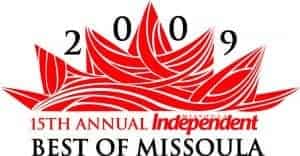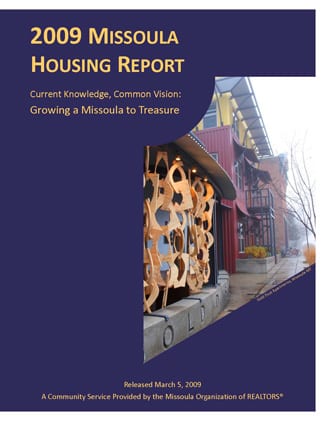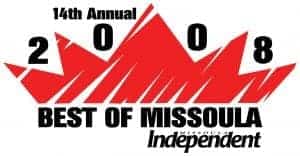 Over the past few years, high-ranking federal government officials have warned us to “never waste a good crisis” or told us, in a variation of that warning, “it’s a shame to waste a good crisis.” Missoula seems to have taken heed of these admonitions, at least with regard to our real estate market.
Over the past few years, high-ranking federal government officials have warned us to “never waste a good crisis” or told us, in a variation of that warning, “it’s a shame to waste a good crisis.” Missoula seems to have taken heed of these admonitions, at least with regard to our real estate market.
How? Amidst the recent downturn some genuinely good, or at least constructive, changes have taken shape. For example, the Missoula housing market, partly as a result of not having home prices previously bid to the stratosphere, has not crashed in terms of homes sold, prices paid, or properties foreclosed. Also, houses have gotten more affordable, especially for first-time home buyers.
Further, homeowners have been reminded that a house is a consumer good, not a tradable commodity or a cash-spewing ATM. Many of us, including leaders of our federal government, have learned through painful experience that some renters are not qualified or suited to be homeowners. Lenders have been reminded that mortgage loans carry risks, and risks must be properly assessed and priced.
This is not to say that the crisis that would be a shame to waste is not a crisis. Much of the data presented in this report document declines and difficulties that are all too real, imposing strains on families and households ranging from sleeplessness all the way to joblessness, divorce, and even homelessness.
With these impacts, the only thing about a “good crisis” that might truly be good is getting out of it. Fortunately, a variety of economic and real estate signals at national, state, and local levels have turned from blinding red to at least a weak shade of green, or a caution indicating yellow.
For example, home prices, except at the top-most ranges, appear to have bottomed, with entry-level homes showing some recent modest gains. December’s increased home sales nationally were likely aided by mortgage interest rates hovering around 5%, the lowest level in decades.
Nationally, new home sales in 2010 are predicted to increase by 25% over their 2009 total, according to National Association of Home Builders senior economist Bernard Markstein. He says a share of this gain will result from a significant drawdown in housing inventory, which at the end of 2009 stood at 1971 levels.
More broadly, shoppers are again opening their wallets. Unemployment may have peaked. The current generation of Americans in the prime household-formation years of 25 to 44, the so-called Echo Boomers, exceeds the Baby Boomer generation in size by more than 5 million members, even without considering population-boosting immigration.
Yet some lights, especially those that influence housing, are still red. Missoula real estate shows signs of a bifurcated recovery: While homes sold for $275,000 and less recently registered gains in sales and price, those priced above $275,000 continue to show deterioration in number of sales and median price.
Also, an unknown number of properties are being held off the market until prices improve. If many of these are offered at about the same future date, prices may again retreat. Another factor is that the foreclosure rate, which ultimately dampens new home sales and prices, could potentially spike, as banks haven’t yet dealt with all of the homes currently under water financially.
A main concern is the ongoing and unprecedented liquidity crisis. Fannie Mae and Freddie Mac were originally established to make sure there was always liquidity in the secondary markets. But they are now on federal life support, with billions of dollars being fed to them until their futures can be determined.
Lenders will continue to assess their risk, which may directly impact the availability of certain programs and underwriting guidelines. The direct impact to the borrower could be larger down payments, additional fees, and higher mortgage insurance premiums, depending on the type of financing.
Ironically, the relative strength of the Missoula housing market compared with the national picture means that housing affordability has not improved locally to the extent it has improved nationally. For the U.S. as a whole, the mortgage payment on a median priced U.S. home had fallen to about 17% of average family income by year-end 2008, from more than 25% two years ago. Affordability arguably remains the greatest challenge in our local market.
This catalog of data seems all-in-all to send mixed messages about 2010 and the early years of our new decade. The consensus forecasts of real estate and economic experts anticipate a slow recovery of the US economy and a likely even slower recovery of US housing.
Locally, a similarly slow progression is likely, according to a many of the speakers at the Missoula Business Forum last December. But one of those speakers, University of Montana economist Larry Swanson, added that our region benefits from starting its recovery from a hole that’s not as deep, in many respects, as it is for much of the country.
We concluded in last year’s Housing Report that “Missoula’s housing market … would be envied by most of the country. This state of affairs … provide[s] realistic potential for a stronger local housing market when the economy begins to rebound.”
We were partially correct in this forecast, as a few important measures, such as number of homes sold and housing affordability improved in 2009. But other measures deteriorated further. As a result, strangely enough, we are left in early 2010 with the same conclusion as in 2009: “This state of affairs … provide[s] realistic potential for a stronger local housing market when the economy begins to rebound.”
It is the economic rebound, nationally as well as locally, that remains elusive. The potential repercussions of the Smurfit Stone & Macy’s closures are yet to be seen, but are likely to slow recovery. The question remains; are recent positive economic indicators, in such measures as home sales, gross domestic product, and unemployment signaling a resumed economic expansion? Or are these “false positives,” with our economy headed for a dreaded “double-dip” or “w-shaped” recession, in which positive signals prove to be only a brief respite before the economy nosedives again?
With the data provided, it is our conclusion that we are likely at the beginning of a recovery, and that Missoula’s economy and housing market will show renewed strength in the near future. Only time will tell if we’re right about that. What we know for certain is that Missoulians will fight through adversity and celebrate the strengths we gain through community.



